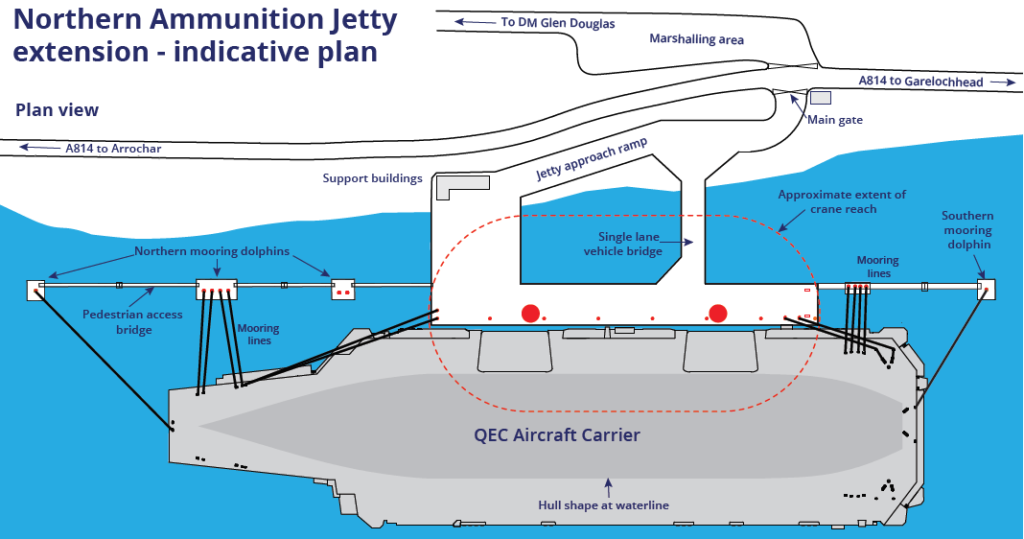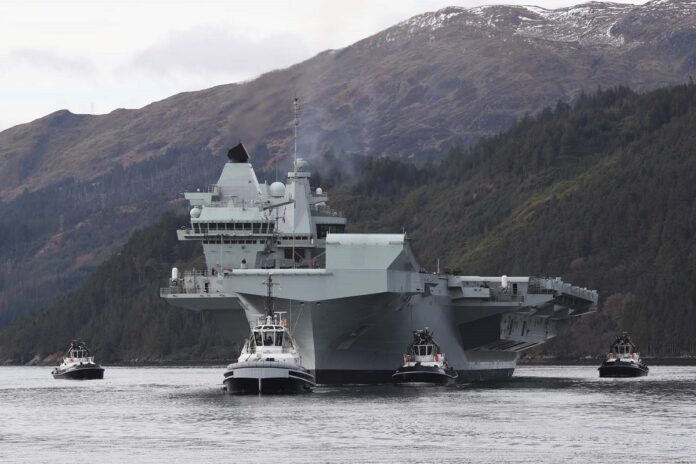The Royal Navy’s Fleet Flagship HMS Queen Elizabeth has arrived in Glen Mallan, Scotland, as part of final preparations before her first operational deployment, the Royal Navy announced with a press release.
Sailing in along the Firth of Clyde (entrance of the Clyde River at Western Scotland), the 65,000-tonne aircraft carrier has spent the last two weeks at sea testing and trialing her latest equipment before berthing at the new Northern Ammunition Jetty for a routine onload of operational stores.
HMS Queen Elizabeth is the first of the Royal Navy’s fleet to visit the new £64m facilities, built by the Defence Infrastructure Organisation (DIO).
Operated by Defence Equipment and Support (DE&S) through Defence Munitions, the Northern Ammunition Jetty is specifically designed to support the surface fleet, allowing them to continue entering and berthing Glen Mallan.

Defence Secretary Ben Wallace said: “HMS Queen Elizabeth has a very proud affiliation to Scotland, and it only fits she returns before her first operational deployment later this year.
“The £64m investment into the new Northern Ammunition Jetty reaffirms our commitment to supporting our core capabilities and defense estate across all corners of the UK.”
This is the first time HMS Queen Elizabeth has visited Western Scotland after initially becoming a familiar sight on the River Forth where she was assembled.
Captain Angus Essenhigh, HMS Queen Elizabeth Commanding Officer, added: “We are very proud of the close connection our ship has with Scotland, especially with our affiliated city of Edinburgh.
“HMS Queen Elizabeth embodies the best of British engineering and craftsmanship, including Scottish shipbuilding, and it is a privilege to return to her birthplace of Scotland.”
DIO project works undertaken the installation of four new navigational aids to ensure safe passage through the confined waterway in Loch Long, two new modular fender spacer units that move with the tide to prevent the aircraft carrier flight deck from coming in to contact with the jetty and the installation of dolphin mooring points to ensure the aircraft can be securely berthed.
HMS Queen Elizabeth is due to sail for Portsmouth at the end of the month and deploy to the Mediterranean, Indian Ocean, and East Asia later this year as part of the UK’s Carrier Strike Group.
HMS Queen Elizabeth:
HMS Queen Elizabeth is the largest and most powerful vessel ever constructed for the Royal Navy. The ship is 280 meters long, has 65.000 tonnes of displacement.
HMS Queen Elizabeth’s flight deck comes in at an enormous four acres and will be used to launch the fearsome new F35 Joint Strike Fighter fast jet. Four fighter jets can be moved from the hangar to the flight deck in just one minute.
The ship’s two propellers weigh 33 tonnes each. Her max speed is 25+ knots.
Defensive weapons include the Phalanx Close-In Weapons System for anti-aircraft and anti-missile defense and 30mm Automated Small Calibre Guns and Miniguns for use against fast attack craft. She would be escorted into high-risk areas by the Type 45 destroyer, which was made specially to fulfill this role. In lower-risk situations, frigates or even patrol vessels may be used instead. It will carry four miniguns and 8 general-purpose machine guns.
Incorporated into the first two blocks is a sophisticated handling and deployment system for air weapons known as the Highly Mechanised Weapon Handling System (HMWHS) to achieve a sortie generation rate six times faster than any previous Royal Navy aircraft carrier. The system requires only 50 people and could be operated with as few as 12 in an emergency; it is estimated that 160 would be needed to produce the same efficiency with conventional equipment. The system moves munitions on pallets through remotely controlled electric vehicles and lifts.



